Baggage Cart with Weighing Mechanism for Hotels and Airlines
by Vishal Verma 1,* ![]()
![]() , Kuldeep Kumar 2
, Kuldeep Kumar 2 ![]() , Rashmi Aggarwal 1
, Rashmi Aggarwal 1 ![]() , Tanvi Verma 1
, Tanvi Verma 1 ![]()
1 Chitkara College of Hospitality Management, Chitkara University, Rajpura, 140401, Punjab India
2 Chitkara Business School, Chitkara University, Rajpura, 140401, Punjab India
* Author to whom correspondence should be addressed.
Journal of Engineering Research and Sciences, Volume 3, Issue 1, Page # 6-10, 2024; DOI: 10.55708/js0301002
Keywords: Baggage Cart, Weighing Mechanism, Customer Satisfaction, Service Quality
Received: 04 October 2023, Revised: 06 January 2024, Accepted: 06 January 2024, Published Online: 30 January 2024
APA Style
Verma, V., Kumar, K., Aggarwal, R., & Verma, T. (2024). Baggage Cart with Weighing Mechanism for Hotels and Airlines. Journal of Engineering Research and Sciences, 3(1), 6-10. doi: 10.55708/js0301002
Chicago/Turabian Style
Verma, Vishal, Kuldeep Kumar, Rashmi Aggarwal, and Tanvi Verma. “Baggage Cart with Weighing Mechanism for Hotels and Airlines.” Journal of Engineering Research and Sciences 3, no. 1 (2024): 6-10. https://doi.org/10.55708/js0301002.
IEEE Style
V. Verma, K. Kumar, R. Aggarwal, and T. Verma, “Baggage Cart with Weighing Mechanism for Hotels and Airlines,” Journal of Engineering Research and Sciences, vol. 3, no. 1, pp. 6-10, 2024, doi: 10.55708/js0301002. http://dx.doi.org/10.55708/js0301002
In this article, it has been proposed a functional design of Baggage Cart with Weighing Mechanism for Hospitality Industry based on empirical observations. This design is expected to promote and become one of the high demand products which can later be used especially by hotels and respective airlines. It has been often observed that travelers are always concerned about the maximum weight of their baggage allowed in order to board a flight. Because as per norms of airlines one needs to carry a specific amount of baggage in the flight, in case of extra weighed baggage carried by a guest, he/she is charged extra amount as per KG by the respective airline. Keeping this point in mind, travelers are always conscious about the weight of their baggage before boarding a flight to avoid the last-minute hassle of paying huge extra money, and sometimes they need to drop the necessary items out from the baggage to adjust the weight of the baggage. In hotels, a guest request to weigh his/ her luggage is dealt with in the following ways: The front office associate/porter first needs to fetch the baggage from the guest room and bring it up to the bell desk or need to drag it up till time office / receiving area where it is weighed on a heavy-duty weighing scale. It is the traditional way of measuring baggage. The traditional way is time-consuming, uncomfortable, and less suitable to support the need of the traveler. Hence, to minimize the time and efforts, we wanted to invent a mechanism that will help and reduce the burden of managing the separate weighing machine, and therefore we came up with a baggage cart with a weighing mechanism in it.
1. Introduction
Passenger Satisfaction is a crucial metric in order to evaluate airport performance. International airports in various regions or countries usually do not compete with each other. Passengers generally do not have the choice to choose between airports, irrespective of the quality and price of airport services. However, Passenger’s demand for airport services is likely to be fairly inflexible [1]. To minimize time, effort, and ease out the task, the design provides a mechanism to weigh the baggage as per the guest’s request. While working in the hotel industry, it was a routine task to deal with guests and their needs and out of all to weigh their baggage was one of them. One genuine problem which is paid less attention and provided with an ordinary, less effective, or non-hospitable solution is the handling of a traveler’s need of weighing his baggage. Moreover, Airports’ key customers are passengers and their initial impressions of airport facilities and services can significantly impact their perceptions and evaluations of the airport. Therefore, it is vital for the airports to provide safe, comfortable and convenient services in a cost-effective manner [2]. Transactions involving goods and services are not the only aspects of business. Its capacity to last is significantly reliant on a variety of humanitarian aspects related to the management and upkeep of commercial relationships with clients, suppliers, and staff, particularly when conducting business internationally [3]. Keeping these in mind, Quality of Service as apparent by customers is a comparison amongst performance and expectations [4]. As per [5], The overall observation of service quality is determined by the modification between customers’ expectations and their actual experiences. When a customer’s experience matches their expectation, service quality is perceived as upright. In other words, Quality of the service is measured by comparing customer expectations with their experiences and this comparison is based on the performance of service delivery. The goal of providing better service to clients is to meet their needs in addition to making sure they are completely satisfied with the service they are utilizing [6]. In the hospitality industry, it is a routine task to weigh the baggage of guests. The proposed design provides a mechanism to weigh the baggage as per the guest’s request with minimal time, effort. Present solutions are not convenient and need the efforts of the porter to fetch the baggage to and fro between the guests’ rooms and hotel utilities which is a time-consuming process.
2. Technical Background
At present, the hospitality industry is using the following mechanisms to weigh the baggage. Based on empirical observations and as shown in Figure 1 below, Earlier In a traditional way, a porter needs to fetch the bag from the guest room which is taken to the time office / receiving area where it is weighed on a heavy-duty weighing scale. The moment it’s being measured, it is properly tagged and delivered to the respective guest room. The process needs to be executed immediately on the guest’s demand as the guest has to check out and take a flight or train. Even a reasonable delay in the process upsets the guests and creates a bad impression of the hotel.
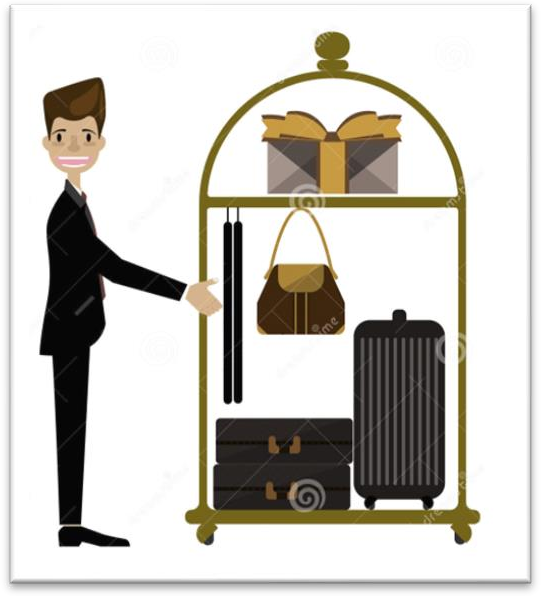
In another mechanism, as per empirical observations and as shown in Figures 2 & 3 below, some hotels use a weighing device with a lifting hook. The porter has to hold the device and lift the bag hooked to the device to weigh it. Sometimes the process may result in a muscular sprain in the porter’s hand or back or lead to dropping the bag, which could again lead to a bad impression of the hotel.
In a few hotels, as per empirical observations and as shown in Figure 4 below, the guest is prompted to measure his / her baggage on his own by using the weighing scale kept in their bathroom. However, this system is not suitable as it is meant for weighing human body weight. In case one holds a bag and stands on the machine, it gives total weight which is not an appropriate method. it’s not even feasible to keep a large piece of baggage on the surface of a weighing scale.
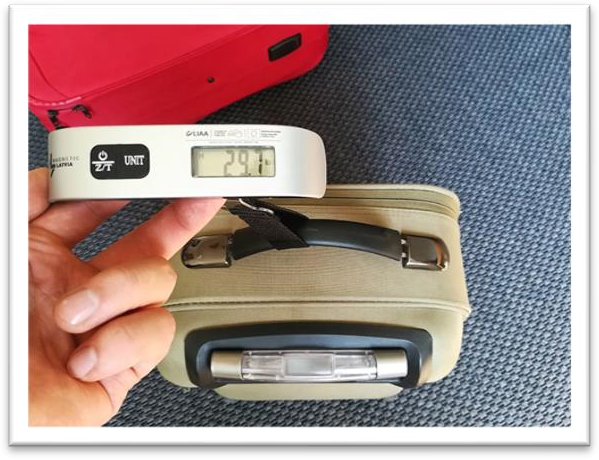
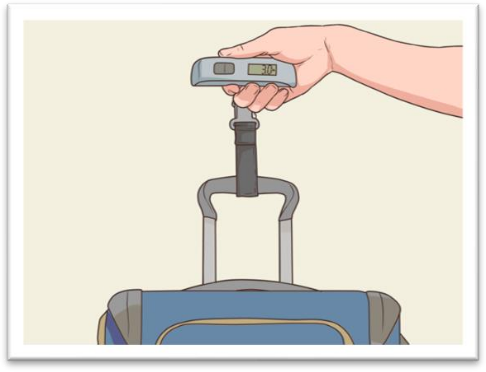
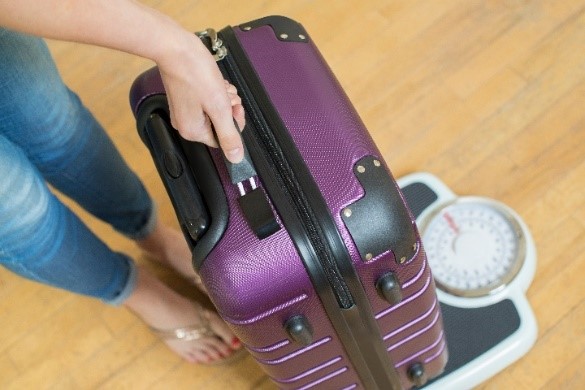
3. Related Work
3.1. Prior Art
As per empirical observations, figure 5 represents the traditional way of measuring the baggage. It would be easy and convenient for the front office associate/porter to use efficient ways to reduce their efforts and save time.
As per empirical observations, the use of the proposed mechanism in baggage cart is not restricted or limited to just hotels only, even the respective airlines can use it during a passenger’s arrival inside the airport, before
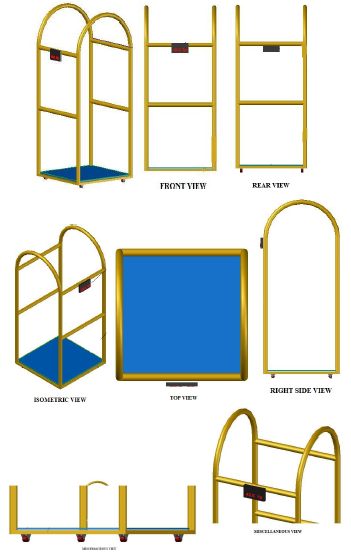
moving towards their flight one needs to finish check-in formalities including the weighing of their bags. Using this mechanism would enable them to get the results faster than the existing ones.
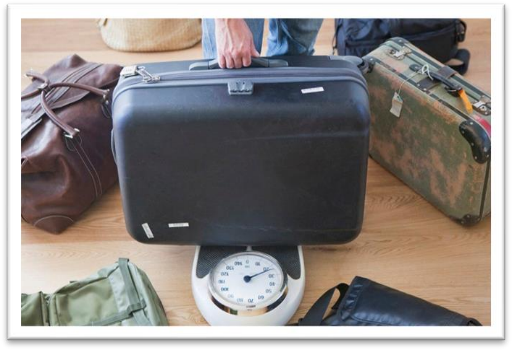
3.2. Advantage of the proposed system in comparison with prior art
- Time Effective: It saves time as it is always available with Front Office / Bell Desk.
- Easy Handling: It is always handy and in use by Bell Desk Staff.
- Reduced Efforts: No more to-and-fro efforts, as a handy baggage cart with a weighing mechanism, is available all the time.
3.3. Proposed Solution
The mechanism was designed to minimize the time and effort required in the traditional weighing method through a separate weighing machine. The proposed design allows installing the weighing mechanism on the baggage cart. The proposed design for Baggage Cart with weighing mechanism for hotels and airlines are shown in figure 6.
4. Hardware Implementation
As per empirical observations, the surface of the baggage cart has a mechanism to measure the weight. Upon placing a bag on the cart’s surface, it will display the weight on the digital display mounted on the cart. The baggage cart will appear like a regular baggage cart when the digital meter is turned off.
5. Conclusions
The product is designed to eliminate the existing flaws used by respective hotels and airlines of guests for weighing their luggage, especially at the eleventh hour of checking out of the hotel. As per the enclosed pictures from 1-4, traditionally these are the methods of fetching baggage and measuring them too which are not at all convenient and time-effective. The most significant advantage of the baggage cart with a weighing mechanism is that it can be used by both hotels and airlines for their purposes. This product is expected to find high acceptance by hospitality professionals because of lesser effort, easy handling, and being time effective.
Conflict of Interest
The authors declare no conflict of interest.
- R. Doganis, The Airline Business, Routledge, 2005, doi:10.4324/9780203596807.
- R. Rendeiro Martín-Cejas, “Tourism service quality begins at the airport,” Tourism Management, vol. 27, no. 5, pp. 874–877, 2006, doi:10.1016/j.tourman.2005.05.005.
- B.K. Das, S. Sharma, “Influence of Relationship & Behavioural Aspects on Customer Retention & Loyalty in B2B Flexible Packaging Industry in Bangladesh,” International Journal of Applied Business and Economic Research, vol. 15, no. 22, pp. 71–81, 2017.
- A. Parasuraman, V.A. Zeithaml, L.L. Berry, “A Conceptual Model of Service Quality and Its Implications for Future Research,” Journal of Marketing, vol. 49, no. 4, pp. 41–50, 1985, doi:10.1177/002224298504900403.
- C Gronroos, Service management and marketing: managing the moments of truth in service competition, Lexington Books, 1990.
- J. Sharma, J. Singh, A. Singh, “Impact of E-Banking Service Quality on Customer Satisfaction,” International Journal of Recent Technology and Engineering (IJRTE), vol. 8, no. 5, pp. 2296–2300, 2020, doi:10.35940/ijrte.E5841.018520.
